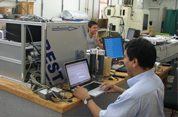Tropospheric Ozone
Quantification of Free Tropospheric O3
The US Environmental Protection Agency (USEPA) classifies ozone as one of six criterion pollutants, i.e., subject to regulation, due to its harmful effects on human and agricultural health. Therefore, it is important to track ozone and to understand the causes of its variability on regional and global scales to improve the accuracy of air quality forecasts and to develop effective control strategies. The current system of surface-based monitoring station is inadequate to this task. “Understanding and modeling tropospheric chemistry on regional to global scales requires a combination of measurements of ozone, ozone precursors, and pollutant gases and aerosols with sufficient vertical resolution to detect the presence, transport, and chemical transformation of atmospheric layers from the surface to the lower stratosphere”. If you need more detailed information on such topics, usually college term papers for sale come to mind when we talk about environmental projects.
Development of satellite sensors that are capable of this type of observations is an important priority for NASA Earth Science. Moreover the planned GeoCAPE mission is aimed at providing high spatial and temporal resolution of ozone and its precursors over North and South America to “satisfy basic research and operational needs related to air-quality assessment and forecasting to support air-program management and public health. (“Decadal Survey 2007”) The Decadal survey recommended the development of satellite sensors that are capable of a “… combination of measurements of ozone, ozone precursors, and pollutant gases and aerosols with sufficient vertical resolution to detect the presence, transport, and chemical transformation of atmospheric layers from the surface to the lower stratosphere.”
The planned GeoCAPE mission is aimed at providing high spatial and temporal resolution of ozone and its precursors over North and South America to “satisfy basic research and operational needs related to air-quality assessment and forecasting to support air-program management and public health.” (Source: Decadal Survey 2007) Since 2005, Howard University has operated an upper air ozone sonde station at HUBC during the summer pollution season. The station has provided observation of ozone profiles for validation of TES on Aura (Nassar et al 2007) verification of NCEP operational air quality forecast models, monitoring of regional transport of ozone by Maryland Department of the Environment (Lee et al 2008), and preliminary studies of the variability of free tropospheric ozone (York et al 2009). As part of continued collaboration with NASA/AURA, and NESDIS/STAR, validation teams and NOAA/NCEP operational modeling group, BCCSO upper air ozone measurements enable year-round operation and better coverage of summer pollution episodes, and improve the quality control, and the timely accessibility of the ozone data.
These measurements will firmly establish the site in the modeling, satellite verification, and monitoring communities. Moreover, they will place it in a strong position to participate in the validation and science components of the GeoCAPE mission. The extended measurements will enable achievement of the following scientific objectives:
- Establishment of climatological statistics and case studies;
- Application of these statistics and case studies for model formulation and optimization of satellite algorithms by URC collaborators (NASA/AURA validation, NESDES AIRS/CRIS validation);
- Quantification of the annual and inter annual variability of troposheric O3 (regional transport, stratospheric/trop exchange, lightening, anthropogenic) and its impact on surface level air quality and air quality model predictability.
During year one and two, effort was initiated to begin extended ozone measurements. In November of 2008, BCCSO established a team of graduate students and staff to begin weekly ozone soundings. The November soundings specifically support TES cal/val. During the N-WAVES experiment, ozone sonde measurements were coordinated with Dr. David Whiteman’s team. During summer 2009 and 2010, they were coordinated with measurement support through MDE to sample high ozone episodes. In addition to measurements, a technician at HUBC was trained to prep and perform soundings, and coordinate a team of graduate students. The technician left BCCSO in year two; but graduate students have maintained measurements and data quality control. With respect to data analysis and the proposed studies, this work will be conducted in collaboration with Dr. Anne Thompson’s group at The Pennsylvania State University. As proposed, the work commenced in year two of the cooperative agreement.
Related Links
We offer exciting research and educational opportunities.
- Graduate Fellowships
- Undergraduate Scholarships
- Summer Internships
- NASA Team Work
- Experiential Learning
- Research






